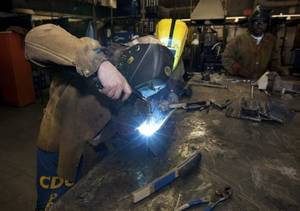SIERRA CONSERVATION CENTER - Before living behind bars, 48-year-old George Harrison did carpentry work in and around Modesto. He felt lucky to land a spot in a prison cabinetry course that would give him greater precision skills to compete in the job market upon his expected release in 2013.
But the real world's dispiriting economy doesn't stop at the prison's heavily guarded front gate.
Staggering under historic budget problems, state leaders are slashing $1.2 billion in yearly prison spending, including two-thirds of inmate education, vocation and substance abuse programs, the very things most likely to turn ex-cons away from crime when they get out.

Inmate Craig Morrow, 49, welds in the "Welding Shop" at Sierra Conservation Center, a state prison in Jamestown, Calif., on Friday, January 29, 2010. Educational programs have been cut due to recent state budget cuts. The welding shop will not be cut, but other vocational programs had to be shut down.
Harrison's mill and cabinet class, the first vocational program established when the prison was built near Jamestown in 1965, ended a few weeks ago, before he could obtain coveted cabinetry certification. Inmates no longer will make award-winning furniture for state offices.
"It's a shame this one's going down," said Lt. Kevin Wise, Sierra spokesman.
Also gone is the position held for 22 years by a woodworking instructor, while a welding teacher next door kept his after 2.5 years on the job. Prison administrators had no say in which programs stayed and which went.
"I feel blessed to have a job, yet I have this knot in my stomach that it's not fair," welding instructor Darren Holman said.
The prison also said goodbye to its print and graphic arts shops, which gave birth for years to Tuolumne County Fair promotional posters. All told, eight instructors got handshakes and pink slips.
Friday was to be their last day. But a notification glitch gave a 30-day reprieve for up to 900 instructors throughout California's prison system.
Tracy's Deuel Vocational Institution will lay off 34 instructors, including Fred Kennedy of Manteca. A former high school teacher, Kennedy said he prefers teaching math, history, science and English to tough, focused men.
"They actually study," Kennedy said. "If I give them homework and come back in a couple of days, it's done. A lot would say, 'Can you give me more?' "
Deuel lifer Michael de Vries compiled several academic reports showing that prison education helps keep paroled ex-cons from offending again. "Study after study supports the idea that this kind of programming reduces recidivism and really provides a lot of bang for the buck for taxpayers," he said in a letter from his cell.
Educators at Sierra Conservation Center emphatically agree.
"You see behaviors change," said Hillary Iserman, vice principal of the foothill prison's education and vocation programs.
'Trying to be ready'
Kenneth Elliott of Stockton is looking forward to parole next year after 15 years in custody. He got serious about his future a couple of years ago, earning Automotive Service Excellence certification for auto body work, identical to "outside" credentials, in a program that's been spared.
"I'm trying to be ready," Elliott said. "The only reason guys come back here, and I've see them come back, is because they don't have something to do. This (training) can help when you get out."
Elliott stepped away from his Bondo job on a car Friday and pointed at an attractive blue pickup nearby. "When I got here I knew nothing about painting," he said. "I just did that truck, and I'm proud of it."
The prison's primary mission is training inmate firefighting crews. Of the 5,500 inmates under Sierra's control, 2,000 are in 19 satellite camps. That training won't be affected by Sacramento-ordered changes in rehabilitative programs.
State prison leaders are putting on a good face despite the cuts, which amount to $250 million. Radical changes include introducing more inmates to classes taught by far fewer teachers, meaning they'll have much more homework to do during free time. The state plans to hire part-time instructors, who can be paid less than full-timers, and recruit teachers' aides from the inmate population.
"Nobody is jumping for joy," said Peggy Bengs, California Department of Corrections and Rehabilitation spokeswoman. "But we are facing reality, and we've come up with a plan to do as much as possible with reduced funding."
Dolores Boutin, 69, sighed when asked how she plans to give individual attention to dozens more prisoners who can speak limited English. Her classroom at the prison near Jamestown contains books geared toward kindergartners.
"It's rough on everyone," Boutin said. "It's also rough on the students because they're missing out."
Instruction will focus on elements proven to reduce recidivism, including high school equivalency diplomas, administrators say.
"We don't want to give the impression that we're just giving up on education," Sierra Warden Frank Chavez said.
What about fire crews?
He wonders how the state's early release orders, which have yet to take shape, might affect his fire crews. They're made up of low-security inmates, the same population targeted to get out before serving their entire sentences, to help bridge the state deficit.
Sierra's firefighters are paid $1 per hour with no overtime bonus. "These guys are saving taxpayers billions of dollars," Chavez said.
Although the cuts were ordered last summer, Gov. Schwarzenegger took another swipe at prisons in his State of the State address a couple of weeks ago, proposing more drastic slashing with savings diverted to universities.
Before prisons began emphasizing rehabilitation a few decades ago, Deuel "was a gladiators' school," said Kennedy, 65. "They were sharpening their toothbrushes to make little knives. With education, you walk down there and see guys doing homework. Their minds are set more on improving themselves than on getting in trouble."











